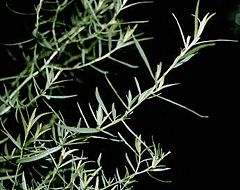Tarragon
| Tarragon | ||||||||||||||||
|---|---|---|---|---|---|---|---|---|---|---|---|---|---|---|---|---|
 |
||||||||||||||||
| Scientific classification | ||||||||||||||||
|
||||||||||||||||
| Binomial name | ||||||||||||||||
| Artemisia dracunculus L. |
Tarragon or dragon's-wort (Artemisia dracunculus L.) is a perennial herb in the family Asteraceae related to wormwood. Corresponding to its species name, a common term for the plant is "dragon herb." It is native to a wide area of the Northern Hemisphere from easternmost Europe across central and eastern Asia to India, western North America, and south to northern Mexico. The North American populations may however be naturalised from early human introduction.
Tarragon grows to 120-150 cm tall, with slender branched stems. The leaves are lanceolate, 2-8 cm long and 2-10 mm broad, glossy green, with an entire margin. The flowers are produced in small capitulae 2-4 mm diameter, each capitulum containing up to 40 yellow or greenish-yellow florets.
Contents |
Cultivation
Tarragon has an aromatic property reminiscent of anise, due to the presence of estragole, a known carcinogen and teratogen in mice, which makes up to 68-80% of tarragon oil.[1] French tarragon is the variety generally considered best for the kitchen, but cannot be grown from seed. Russian tarragon (A. dracunculoides L.) can be grown from seed but is much weaker in flavour.
However, Russian tarragon is a far more hardy and vigorous plant, spreading at the roots and growing over a meter tall. This tarragon actually prefers poor soils and happily tolerates drought and neglect. It is not as strongly aromatic and flavoursome as its French cousin, but it produces many more leaves from early spring onwards that are mild and good in salads and cooked food. The young stems in early spring can be cooked as an asparagus substitute. Grow indoors from seed and plant out in the summer. Spreading plant can be divided easily.
Usage
Culinary use
Tarragon is one of the four fines herbes of French cooking, and particularly suitable for chicken, fish and egg dishes. Tarragon is one of the main components of Béarnaise sauce. Fresh, lightly bruised sprigs of tarragon may be steeped in vinegar to impart their flavor.
Tarragon is used to flavor a popular carbonated soft drink in the countries of Armenia, Georgia and, by extension, Russia. The drink—named Tarkhun (IPA: [tar'xu:n], թարխուն, Тархун), which is the Armenian, Persian and Russian word for tarragon—is made out of sugary tarragon concentrate and colored bright green.
Cis-Pellitorin, an isobutylamide eliciting a pungent taste, has been isolated from Tarragon plant.[2]
Quote
"I believe that if ever I had to practice cannibalism, I might manage if there were enough tarragon around." --James Beard
References
- ↑ Surburg, Horst; Johannes Panten (2006). Common Fragrance and Flavor Materials: Preparation, Properties and Uses. Wiley-VCH. pp. 233. ISBN 9783527607891.
- ↑ Gatfield IL, Ley JP, Foerstner J, Krammer G, Machinek A. Production of cis-pellitorin and use as a flavouring. World Patent WO2004000787 A2
External links
- Germplasm Resources Information Network: Artemisia dracunculus
- NRCS: USDA Plants Profile: Artemisia dracunculus
- Flora of Pakistan: Artemisia dracunculus
|
||||||||||||||||||||||||||||||||||||||||||